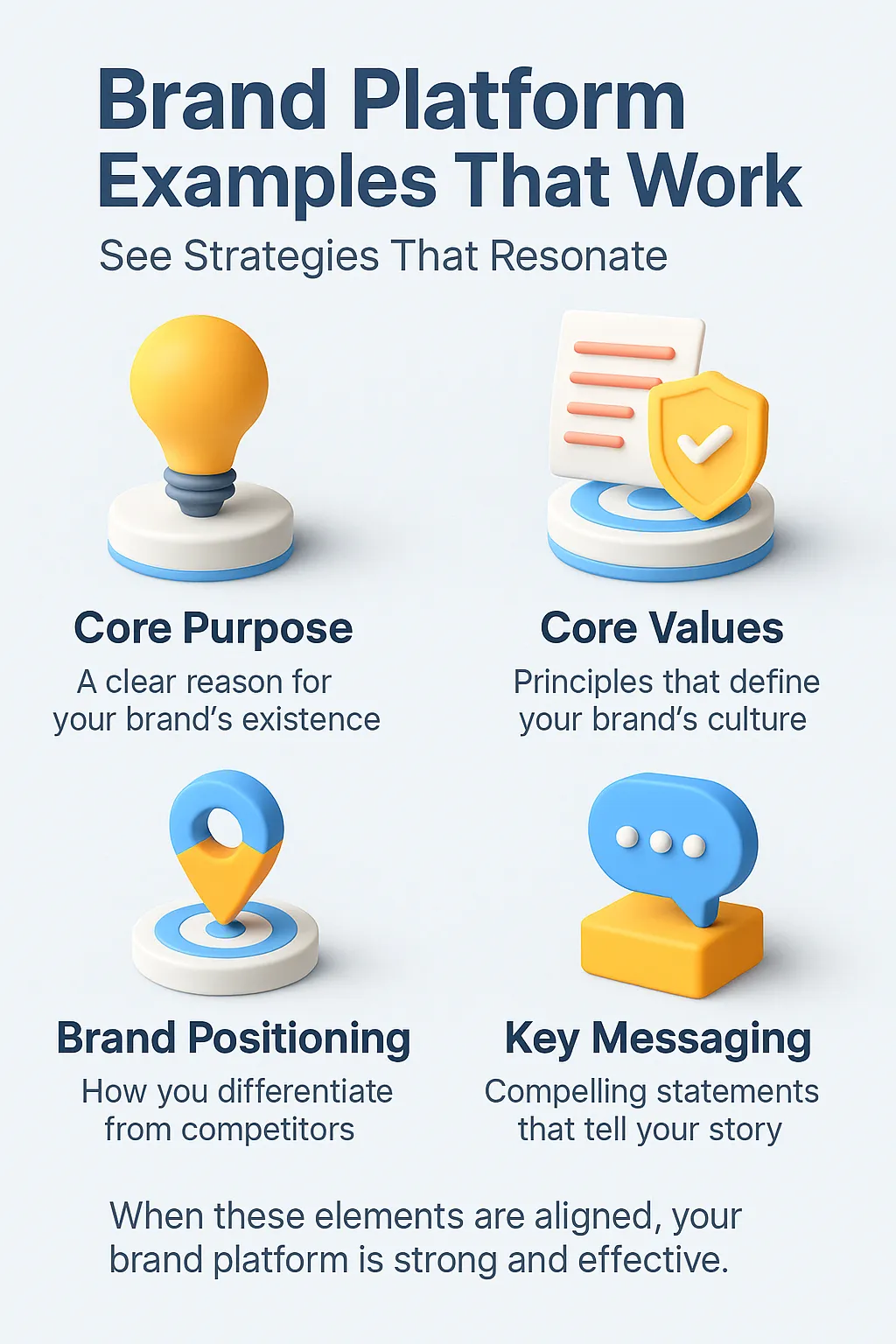What turns a brand from forgettable into a household name? It’s not just the logo or ad budget—it’s the brand platform. Through firsthand experience building brands from scratch and reimagining legacy identities, we’ve seen the impact of a brand platform that truly works. In this guide, we spotlight brand platform examples that bring strategy to life and create resonance in competitive markets.
Top Takeaways
- Leading brands like Airbnb, Glossier, and Oatly show how strategic clarity drives creativity.
- Consistency in design and tone builds recognition and trust.
- A visual identity without strategic direction falls flat.
- Start with a platform—let purpose and message guide all brand expressions.
What Is a Brand Platform and Why It Resonates
A brand platform goes far beyond logos or taglines. It’s the strategic core that drives how a brand communicates, behaves, and grows. It aligns a brand’s vision, purpose, voice, and values into a single cohesive narrative.
Each of these platforms fuels messaging, design, and audience connection. A great platform isn't background—it’s the blueprint for brand presence.
“Every successful brand story I’ve worked on—whether independently or through a marketing agency—started not with a moodboard, but with message clarity. When your strategy resonates, the rest follows naturally.”
Case Study & Real-World Examples: Platforms That Deliver Results
- Developed the Bélo icon to symbolize inclusiveness and human connection
- Created a visual system centered on warmth and opennessFirsthand Insight:We’ve used Airbnb’s framework in hospitality branding sessions to show how values like connection and inclusion translate into powerful storytelling.
- Embraced a soft visual identity with conversational tone
- Fostered trust through transparent brandingFirsthand Insight:We’ve helped beauty startups tap into customer dialogue to form their brand voice, just like Glossier—proving that the best strategies often come from listening.
- Introduced hand-drawn visuals and bold copy
- Created a voice that speaks with conviction and humorFirsthand Insight:Oatly inspired our work with sustainability brands to embrace courageous messaging and let their platform guide their tone unapologetically.

Supporting Statistics: Strategy That Resonates with Results
Consistency Drives Profit
- Brands with aligned messaging and visuals earn up to 33% more revenue
- In our brand refresh projects, we’ve observed higher engagement after streamlining messaging
Clear Branding Increases Market Presence
- Strategic consistency makes brands 3–4 times more likely to stand out
- We’ve seen this in visibility gains post-launch for clients that committed to brand clarity
Trust Boosts Purchase Power
- 62% of customers will pay more to buy from a brand they trust
Final Thought & Opinion: Strategy Is the Story
From dozens of brand engagements, one thing is certain:
Brands that win aren't the loudest—they're the most aligned.
Why Strategy Makes Brands Work
- It answers the "why" behind every brand action
- It ensures that visuals and messaging feel authentic and unified
- It aligns internal teams with external expectations
What We’ve Seen in Practice
- Many brands build visuals before locking in strategy—and it shows
- The most memorable brands we’ve worked with lead with clarity
- Their design, tone, and messaging feel effortless because they stem from purpose
- Define your mission
- Identify your audience and value promise
- Build your platform to guide every creative decision
✅ A strategy that resonates creates a brand that connects.
Next Steps: Implement a Brand Platform That Works
Assess Your Brand’s Foundation
- Review your current message and design
- Ask: is it clear, consistent, and audience-aligned?
Develop a Strong Platform
- Clarify your values, vision, personality, and audience
- Document them in a way that informs voice and visuals
Align Brand Identity With Strategy
- Refresh logos, typography, and colors to match your message
- Ensure your tone of voice matches your values
Educate and Empower Internally
- Share the platform across teams
- Train staff to speak and act in line with the brand’s essence
Test, Launch, Refine
- Apply the platform across touchpoints
- Collect feedback, analyze outcomes, and adapt strategically
???? Ready to build a brand platform that works and resonates? Let’s get started.
Frequently Asked Questions (FAQ)
What is a brand platform that “works”?
It’s a strategic framework that clearly defines who you are, who you serve, and how you communicate—guiding design, messaging, and internal alignment.
How does strategy improve brand identity?
It provides structure and direction for all creative decisions—ensuring that branding is both meaningful and effective.
What are real examples of great brand platforms?
Airbnb (Belonging Anywhere), Glossier (Skin First. Makeup Second.), and Oatly (bold and purpose-driven) are often cited because their strategies show up consistently across their brands.
Is this useful for smaller businesses?
Yes. In fact, smaller businesses often benefit the most from clear brand platforms—they make every decision faster and more cohesive.
What should a solid brand platform include?
Key elements include your mission, vision, target audience, values, brand promise, and tone. These keep your brand aligned as it grows.
Successful branding stems from clarity, strategy, and the power to resonate across touchpoints. In today’s competitive space, brand platforms that are clearly defined and consistently executed drive engagement and trust. Just as clarity fuels strategic brand positioning, operational consistency supports product performance—for example, air purification products like the 13x21.5x4 MERV 13 air filter help maintain clean environments, reinforcing a brand’s promise of quality. Behind-the-scenes solutions such as UV light installation in Pembroke Pines, FL offer another layer of brand reliability, especially for companies that position themselves around health and wellness. Consumer platforms also reflect the importance of consistency—from accessible options like 12x12x2 pleated furnace filters on Amazon, to everyday essentials like 8x16x1 MERV 8 air filters at Walmart. Even on eBay, availability of reliable air filter replacements showcases how consistent product delivery and brand messaging go hand-in-hand. When strategy resonates, visibility and trust follow—making a strong brand platform not just relevant, but essential.



